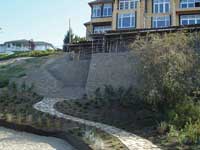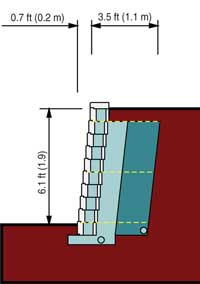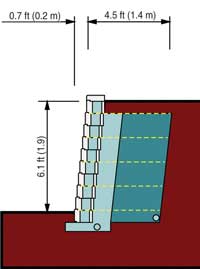Technical Newsletter
Issue 13

Project Information
Product: AB Europa Collection
Size: 12,000 ft² (1,114 m²)16 ft (4.9 m) tall
Local Engineer: ROV Consulting, Kelowna, BC
Allan Block Manufacturer:
Expocrete - Richmond, British Columbia

Internal Compound Stability (ICS) Vs. Global Stability
ICS is used to provide a higher level of check to a segmental retaining wall design. Global stability is used to determine the stability of the entire site.
It should be noted that ICS does not replace the need for global stability analysis. For the larger site stability design, the owner should retain a geotechnical engineer that is familiar with the site conditions. The geotechnical engineer will be responsible for the global stability of the entire site including the soils below the base of the walls and surcharges above the wall.


Figure 1: Older Design - No Longer Compliant

Figure 2: Current Design Option
Upgrading To Allan Block – Cast-In-Place No More
When a retaining wall is required there are still many engineers that lean towards a cast-in-place concrete wall. This project was no different since ROV Consulting, Inc. originally designed this high-end residential project with a concrete wall. However, after the local Allan Block representative spoke with the firm about segmental retaining wall SRW design, they started to see the advantages the Allan Block system offered.
The design flexibility of the system allowed for the walls and stairs to be easily integrated, which gave the project a whole different direction. Additional patio and terraces were explored to give the homeowner even more options to enjoy their backyard. ROV Consulting used the newly acquired information about Allan Block as well as the design software, AB Walls design software, to examine the structural possibilities.
You can imagine how happy the general contractor was when he was provided multiple quotes by AB Certified Wall Installers and the pricing was much more attractive than the original cast-in-place concrete wall. The ease of construction when using the AB Wall system in comparison to the additional labor requirements of the form work and continuous concrete footing of a concrete wall made the installation pricing significantly less. To satisfy the homeowners aesthetic requirements, the general contractor had the homeowner stop in at a local dealer’s yard to look at the different color and pattern options available in the AB Europa Collection. The homeowner was very pleased with the AB Abbey Pattern and construction soon followed.
By using the Allan Block products, all three decision makers, the engineer, the contractor and most importantly the homeowner were very satisfied. The end result was a beautiful and functional wall that was cost effective to plan, design and build while also meeting all of the project requirements.
SRW’s vs. Cast-In-Place Walls
For decades, commercial site developments have commonly constructed cast-in-place reinforced concrete walls to retain soil. However, since the mid 1980’s, segmental retaining walls (SRW’s) have provided a better solution to these rigid walls. Some of the advantages SRW’s have over cast-in-place walls include the following:
- Lower installation cost
- Limited excavation for footing preparation since frost depth is not a factor
- Faster installation
- Easier to design
- Better aesthetics
- More reinforcement options (e.g. Geogrid, No-Fines concrete, wall anchors, etc.)
- Flexible vs. rigid system
Aside from all the advantages listed above, what is often missed is the fact that SRW’s can also out-perform rigid walls, particularly in the most aggressive circumstances possible, such as during an earthquake. SRW’s ability to withstand seismic loading conditions has been proven in both the laboratory and the real world.
Allan Block’s full-scale seismic testing documented that SRWs can withstand large seismicforces. The testing subjected the test walls to forces up to 0.8g and all experienced only minimal deflection and/or settlement. The tests showed the block facing, soil mass and geosynthetic reinforcement all moved together as a unit, in phase with the earthquake induced forces. It was suggested by Dr. Hoe Ling from the Columbia University that these structures,that are both flexible and coherent, are ideal for seismic conditions (AB Seismic Research Summary, Reference Document #R0505, August 2003).
SRW’s were shown to perform well under laboratory conditions, but what about an installed wall that has experienced an extreme seismic event? SRW’s installed in seismically active zones have shown time and time again the advantages a flexible system has over rigid walls. This was further documented in a recent FHWA publication (FHWA – HRT- 11-030 March 2011) which summarizes the impact to transportation infrastructure from the February 27, 2010 Maule earthquake in Chile.
The Evolution of Segmental Retaining Wall (SRW) Design
SRW design and construction have evolved significantly over the years. Block characteristics such as increasing compressive strengths while limiting adsorption rates have changed to increase the durability of the blocks. Design approaches have also evolved.
For example, when engineers first started specifying geogrid reinforced walls, it was common for a retaining wall to have four course spacing of heavyweight grid at a length of 50% the wall height
(Figure 1). This design no longer satisfies today’s design methodologies. Even with External Stability reviews providing good factors of safety, field performance indicated that inadequate construction practices yielded some substandard wall performance. This may be attributed to compaction not being performed in 8 inch (200 mm) lifts.
Additionally, Internal Stability analysis did not capture potential slip planes when grid spacing was set at wider distances apart. The results of Allan Block’s full scale seismic testing, the only such testing in the industry, illustrated the advantages of using grid at two course – 16 inch (400 mm) spacing as shown in Figure 2. Closer spacing allows for lighter weight grid to be used and the formation of a better performing, more cohesive mass, and interrupting potential slip planes between grid layers. The seismic testing also refined the load distribution from a seismic event to mirror a rectangular distribution along the entire face of the wall system. Primary grid lengths were reduced from 70% of wall height to 60% with the top layer being extended to 90% to bridge between the retained soil and the reinforced soil mass.
In the past, wall designs have typically been limited to internal stability, external stability and bearing analysis. In recent years, it has become more customary for an Internal Compound Stability (ICS) analysis to be performed. ICS calculations determine the factors of safety for potential slip surfaces which pass through the unreinforced retained soil, the reinforced soil mass and the wall facing within the wall design envelope. These calculations include the effects of the following:
- Infill and retained soil strength
- Individual grid layer strengths and spacing
- Shear and connection strength the SRW facing brings to the system
ICS provides the advantage of analyzing both internal and external stability together, which brings a higher level of verification of the stability of a reinforced mass. Allan Block has been leading the industry by promoting the advantages of ICS analysis and was the first to include it in our design software.
SRW’s have become a cost effective and reliable option for virtually all retaining wall projects. SRW design, construction and performance have continued to improve, and much of this advancement has been and will continue to be influenced by Allan Block’s research and development.



